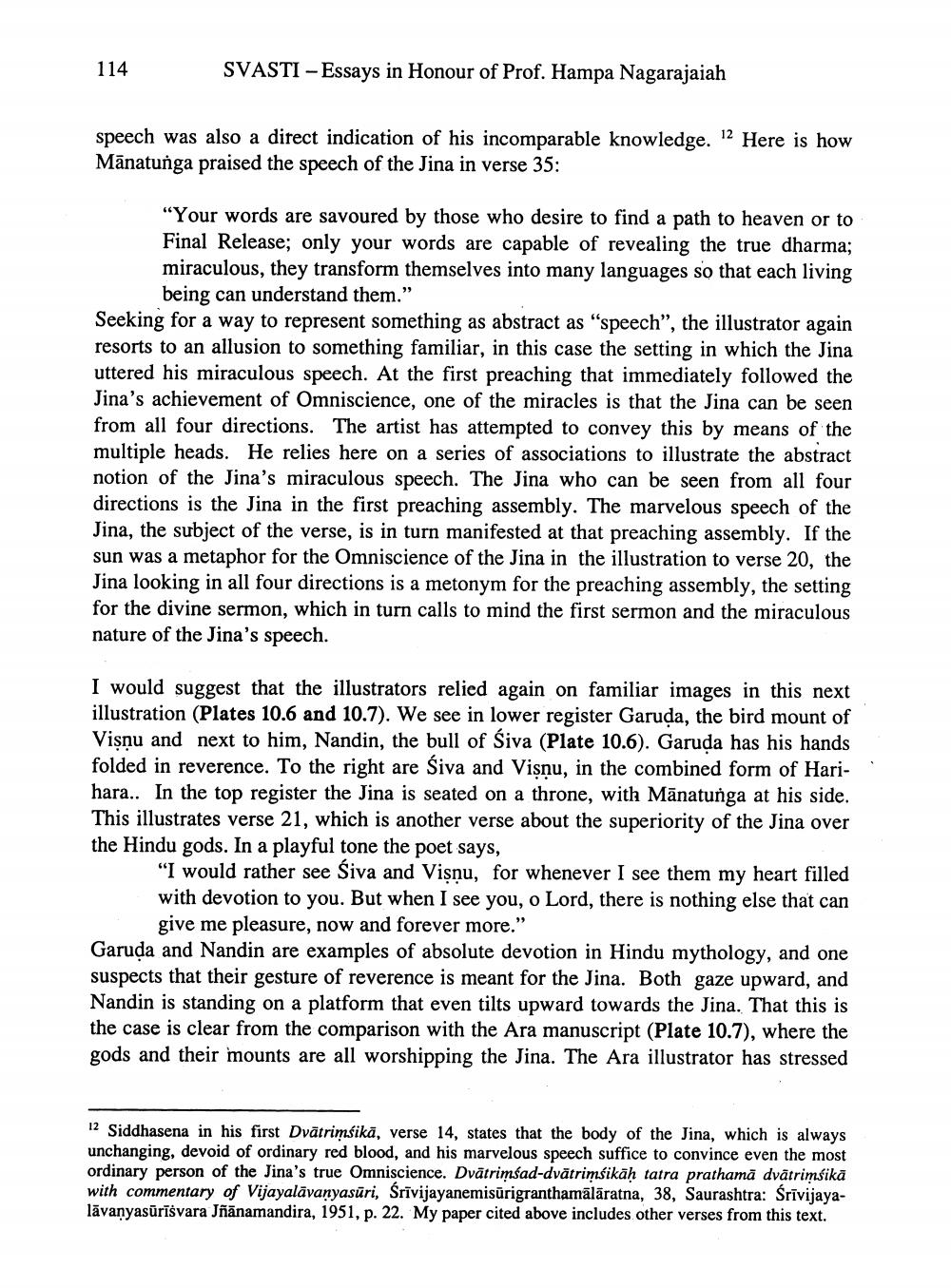________________
114
SVASTI - Essays in Honour of Prof. Hampa Nagarajaiah
speech was also a direct indication of his incomparable knowledge. 12 Here is how Mānatunga praised the speech of the Jina in verse 35:
"Your words are savoured by those who desire to find a path to heaven or to Final Release; only your words are capable of revealing the true dharma; miraculous, they transform themselves into many languages so that each living
being can understand them.” Seeking for a way to represent something as abstract as "speech”, the illustrator again resorts to an allusion to something familiar, in this case the setting in which the Jina uttered his miraculous speech. At the first preaching that immediately followed the Jina's achievement of Omniscience, one of the miracles is that the Jina can be seen from all four directions. The artist has attempted to convey this by means of the multiple heads. He relies here on a series of associations to illustrate the abstract notion of the Jina's miraculous speech. The Jina who can be seen from all four directions is the Jina in the first preaching assembly. The marvelous speech of the Jina, the subject of the verse, is in turn manifested at that preaching assembly. If the sun was a metaphor for the Omniscience of the Jina in the illustration to verse 20, the Jina looking in all four directions is a metonym for the preaching assembly, the setting for the divine sermon, which in turn calls to mind the first sermon and the miraculous nature of the Jina's speech.
I would suggest that the illustrators relied again on familiar images in this next illustration (Plates 10.6 and 10.7). We see in lower register Garuda, the bird mount of Visnu and next to him, Nandin, the bull of Śiva (Plate 10.6). Garuda has his hands folded in reverence. To the right are Śiva and Vişnu, in the combined form of Harihara.. In the top register the Jina is seated on a throne, with Mānatunga at his side. This illustrates verse 21, which is another verse about the superiority of the Jina over the Hindu gods. In a playful tone the poet says,
"I would rather see Siva and Visnu, for whenever I see them my heart filled with devotion to you. But when I see you, o Lord, there is nothing else that can
give me pleasure, now and forever more." Garuda and Nandin are examples of absolute devotion in Hindu mythology, and one suspects that their gesture of reverence is meant for the Jina. Both gaze upward, and Nandin is standing on a platform that even tilts upward towards the Jina. That this is the case is clear from the comparison with the Ara manuscript (Plate 10.7), where the gods and their mounts are all worshipping the Jina. The Ara illustrator has stressed
12 Siddhasena in his first Dvātrimśikā, verse 14, states that the body of the Jina, which is always unchanging, devoid of ordinary red blood, and his marvelous speech suffice to convince even the most ordinary person of the Jina's true Omniscience. Dvātrimsad-dvätrimfikāh tatra prathamā dvātrimfikā with commentary of Vijayalavanyasuri, Srivijayanemisūrigranthamālāratna, 38, Saurashtra: Srivijayalāvanyasūrīšvara Jñānamandira, 1951, p. 22. My paper cited above includes other verses from this text.




